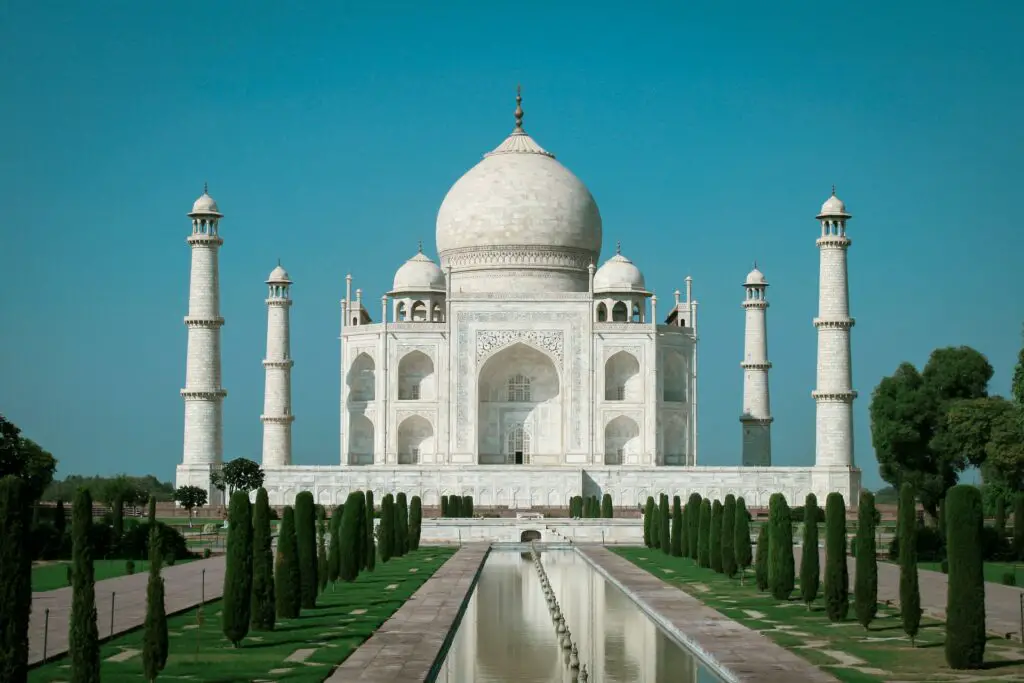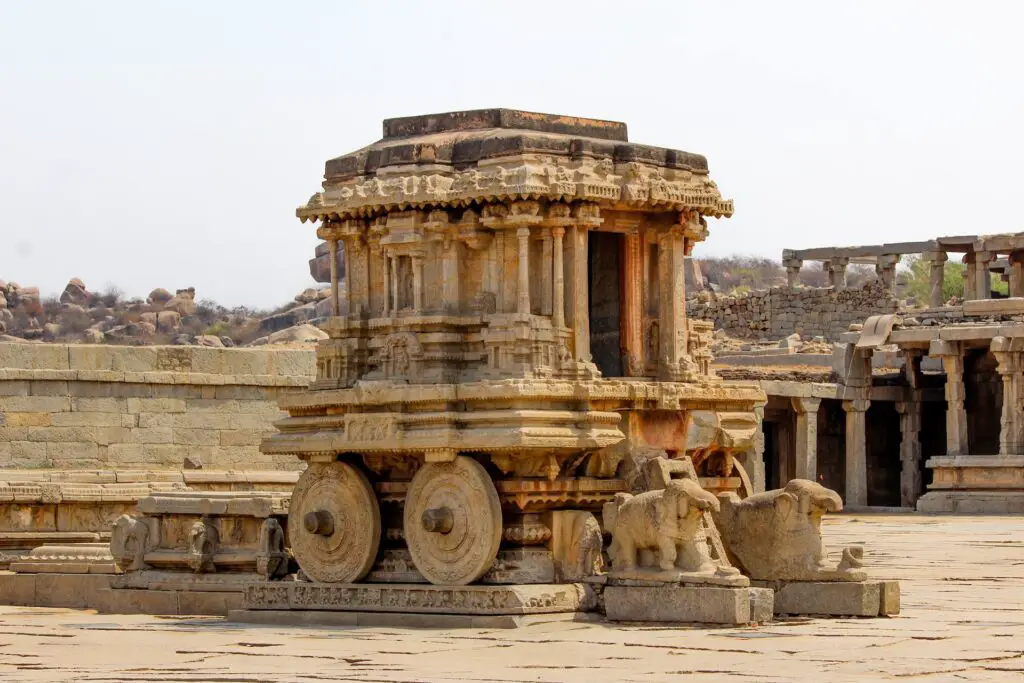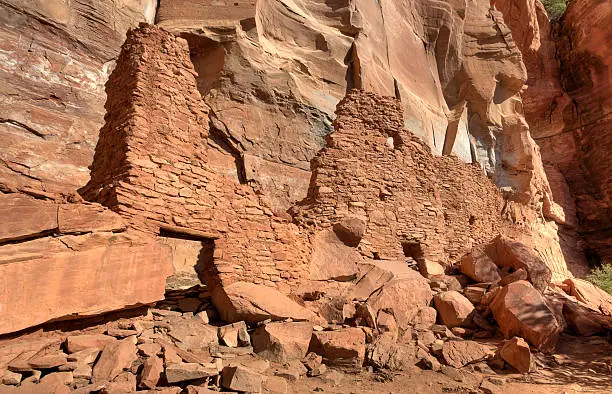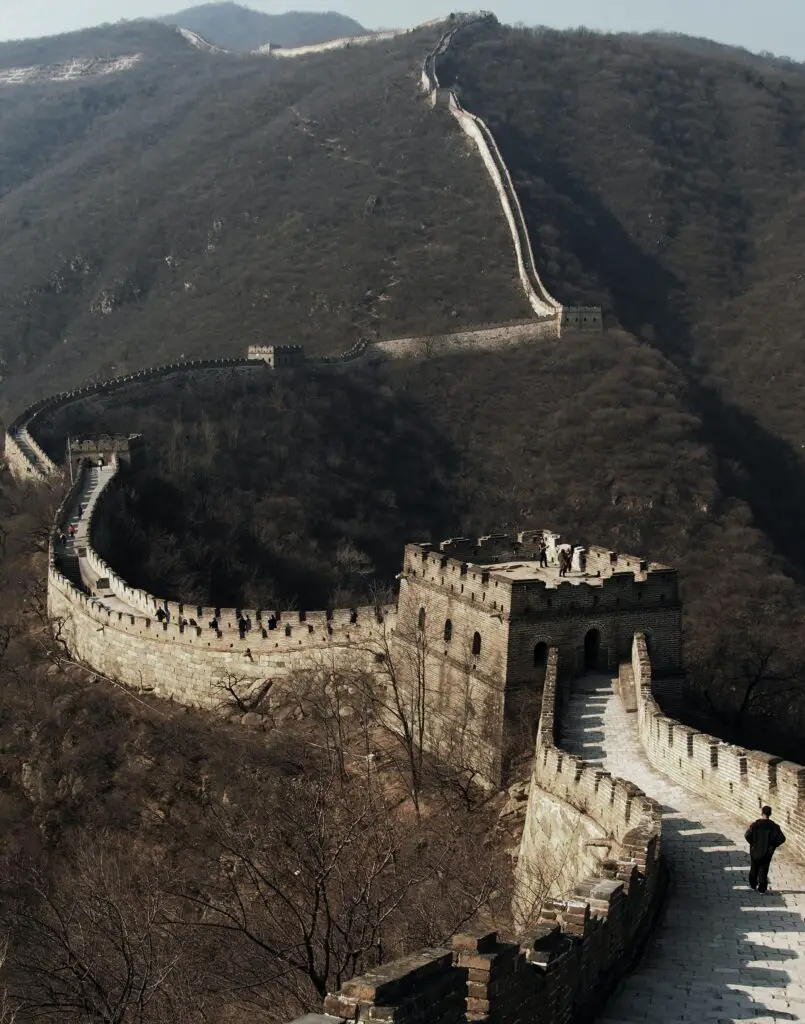You might know about what are the 7 Wonders of the World? And what are the world’s best ancient monuments? But here we are going to explain about India’s one of the finest, oldest and most ancient Cave temples. Those are really challenging to the present generation especially from its constructions, architecture and paintings.
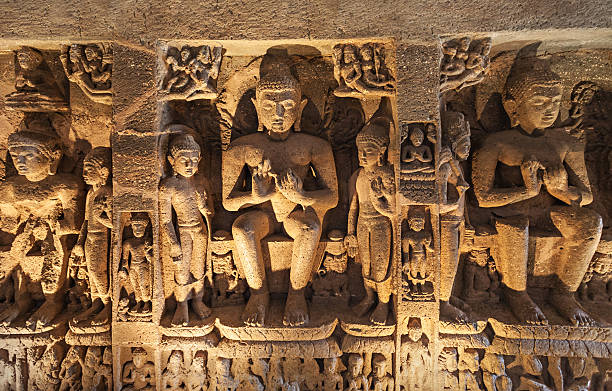
India is known for diverse cultures, architecture and temples. Here we added 2 more cave temples which were built around the 2nd century and built and popularized during the Rashtrakuta dynasty. Over a period of time the temple was attacked by the many Islamic invaders and tried to destroy the temple but couldn’t. They damaged its ideals and caves partly. Due to many reasons, temples later disappeared. A British hunting party in 1819 re-discovered the site and showed the peoples of India lost their most precious gem which is the real wonder to the world that is “Ajanta and Ellora Cave Temples”.
Ajanta Caves

Located in the city of Aurangabad in Maharashtra, attracts millions of visitors after its excavations. It includes a total of 30 rock -cut Buddhist caves, paintings and murals. Most of these caves and paintings exhibit the teachings and the life of Buddha. And these caves are considered as the most well preserved caves in the world.
UNESCO World Heritage site where you can explore the most beautiful Buddhist sculptures in the world. Surely perfect example to the intricate carvings, artist talents which are perfect landmarks to explore Indian architectural marvels and beauties. Let’s discuss in details;
1. History
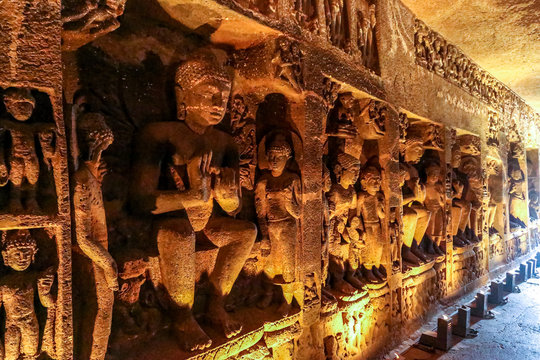
The Ajanta Caves are one of the best examples of Indian Architectures and cultures. It is home to a group of 30 rock-cut Buddhist cave monuments located in the state of Maharashtra, India. When it comes, its history dates back to the 2nd century BCE and it continued until the 6th century.
Here history of Ajanta caves are bifurcated into 2 parts as Satavahana and Vakataka periods.
-
Satavahana period
The Satavahana period is the starting point of the cave constructions like Cave no, 9, 10, 12, 13 and 15A. Scholars argue that these caves belong and are heavily influenced by the Hinayana group of Buddhism. A group of researchers including Walter Spink estimated the period of construction around 100 BCE to 100 CE. Majority of Buddhists believe that these caves were built with patronage by the Satavahana dynasty. Therefore we call it the Satavahana period and some historians argue that these caves are from the Mauryan periods.
Under these caves 9 and 10 are stupa, which is worship hall and caves 12, 13 and 15A are based on the Vihara or simply called as a residence for Buddhist monks. Under these caves you will see many beautiful paintings and sculptures. Interestingly these sorts of Buddhist ideologies are heavily influenced by the Hindu traditions and cultures.
-
Vakataka Period
The Vakataka Period is another journey of this cave temple. According to historians, caves were built between the 4th and 7th centuries. Cave number 1-8, 11 and 14-29 are majorly built during this Vakataka Period. King Harishen from the Vakataka dynasty heavily contributed to build these caves and was also considered as a chief patron of these caves. Caves belonging to another group of Buddhism is Mahayana phase, and it is home to many paintings and sculptures.
Cave 19, 26 and 29 are the chaitya Grihas or simply call it as the prayer hall and rest of the caves are viharas or residences for Buddhist monks. Here you can see all caves are completed and not like caves during the Satavahana period. According to research Cave 1 was commissioned by Harisena and cave 17-20 under Upendra gupta. Under that, Cave 26 is continued to be under construction because it is commissioned by the Asmaka king.
After 478-480 you can see no more caves were constructed and they added to the existing ones. Such as adding statues, shrines, walls for inside caves and returning the side of the entrance. Most of the caves and style of arts were based on the Spink’s chronology.
We can also extend its historical background when rediscovered by a British hunting party in 1819, after being forgotten for centuries, especially cave 10. After his discovery the cave became more famous especially its location, architecture and rock cut arts.
The caves of Ajanta became more renowned for their intricate sculptures and paintings that depict the life of Buddha and various aspects of Buddhist teachings.
2. Facts
There are some interesting facts about this Ajanta Caves and it will leave you more.
- The caves are a UNESCO World Heritage site and listed in 1983. Due to its exquisite murals, sculptures and masterpieces of Buddhist painting are more popular.
- Interestingly these caves disappeared after the end of King Harisena, especially caves like 3, 5, and 8. But during 1819 John Smith discovered these caves and again showed them to this world.
- They are carved into a horseshoe-shaped cliff overlooking the Waghora River.
- Home to fantastic mrunal painting. Most of the painting belongs and is heavily influenced by Buddhist philosophy like Buddha’s life and Jataka Tales.
- It is a hub of 30 minor caves. Cave 1- The Tale- Taller of Jataka, Cave-2 the prowess of women, Cave-9 Hinayana Buddhism and Cave 10 and 26.
- The caves feature monastic quarters and viharas (monasteries) alongside chaityas (prayer halls).
- Architecture carved over 5000 years ago. Tourists will enter the temple through caves 15 and 16 and elephant and snake carving decorations.
- The frescoes, significant for their historical and artistic importance, illustrate various Jataka tales (stories of Buddha’s previous lives).
- Most visited ancient monuments in India, which includes dancing girls, maids, princesses, pink elephants, lovers and golden geese and bullfights. As per domestic data, the monument will receive around 5 lakh visitors in 2023 after Taj Mahal.
3. Paintings
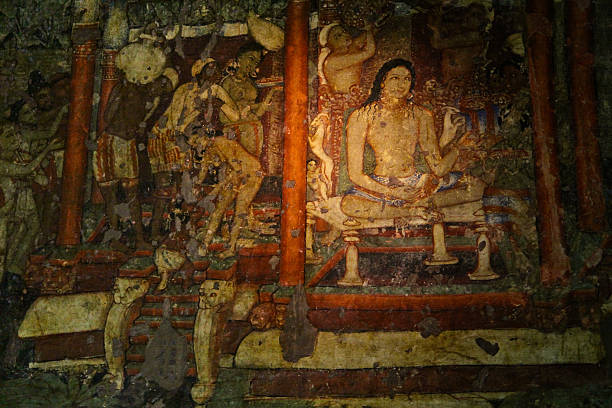
If you see in Ajanta Caves what are the intrinsic features of this temple or monuments, probably we can say that’s its Buddhist caves, architectures and its paintings. Majority 29 caves are made by just hammer and chisel and it shows the life of Buddha. Caves painting and its materials used such as cow dung and clay and colored like yellow, brown and white. Here 5 examples for best paintings in Ajanta Caves;
-
Bodhisattva Padmapani
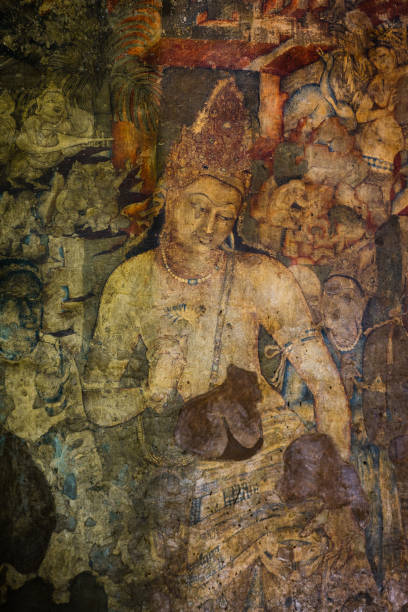
Bodhisattva Padmapani you will see in cave 1 and this sort of painting which shows Buddha’s former existence. However, Cave number 1 of Ajanta Caves is popular for its most intrinsic carving and sculptures of the life of Gautama Buddha.
-
Jataka Tales

Jataka Tales’ painting shows us about the King Janaka of Videha. Under this painting he is sitting with his wife and maids and talking to his wife. Scholars say that the painting which represents his conversation with his wife is about why he wants to renounce his worldly life, live a life of solitude and lead to salvation.
-
The Painting of Persian Ambassador

Under the Cave 1 of ceiling painting is all about explaining the importance of Persian cultures in ancient India. Ceiling not show any story here but general motifs show us. Here you can see a Persian person (Ambassador) surrounded by the dark skinned native peoples.
-
Buddha’s paintings

Cave 6 is all about Buddha paintings, which shows us painting on the doorways and depicts different stages of Gautama Buddha’s life events. It is a double storey cave used as home to many Buddhist monks. Painting explains the Buddha’s figure seated in this cave.
-
Doorway paintings

According to historians and scholars, Doorway paintings are all about normal conversation between kings and peoples. King and communities discussing each other while eating and drinking in the Kingdom.
The paintings of the Ajanta Caves are well depicted and a perfect example of ancient Indian art. Due to its vibrant colors, intricate details, and spiritual themes are striking, showcasing the artistic skills of that era.
4. Location
The Ajanta Caves are located in the Aurangabad district of the Indian state of Maharashtra. It is just 100 kilometers (62 miles) from the city of Aurangabad. If you can also reach the nearest major city is Nashik (267 kilometers) and the caves are situated in a secluded ravine, surrounded by dense forests.
5. Ticket Prices
Ajanta caves entry timings are between 9 AM to 5 PM except Monday. As per the latest information’s ticket prices are;
– Indians: ₹35 per person
– Foreigners: ₹550 per person
– SAARC countries peoples: ₹35 per person
– Children’s below the age of 15 years are free to enter.
Remember there may be extra charges for photography and guides. It’s always better to check prior in official website for the most current prices before planning your visit.
6. Timings
-The Ajanta Caves are open to visitors from; 9:00 AM to 5:30 PM
– And caves are closed on Mondays and even during certain public holidays.
It is always a better idea to visit early in the day to avoid crowds and get a better experience.
Ajanta Caves really gave more push to the Indian architecture, especially its constructions. Above elements make Ajanta Caves a remarkable destination for history lovers, art enthusiasts, and spiritual seekers alike.
Ellora Caves
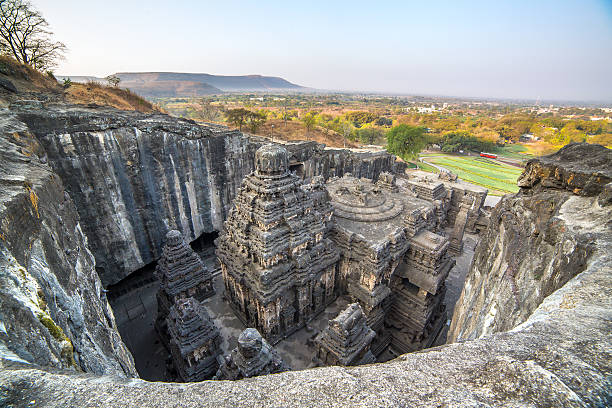
Like Ajanta Caves, Ellora is also well known for Caves and many Hindu and Jain monuments. Symbol of magnificent caves out of rocks and “largest ancient rock cut cave temple in the world”. Let’s discuss even more;
1. History
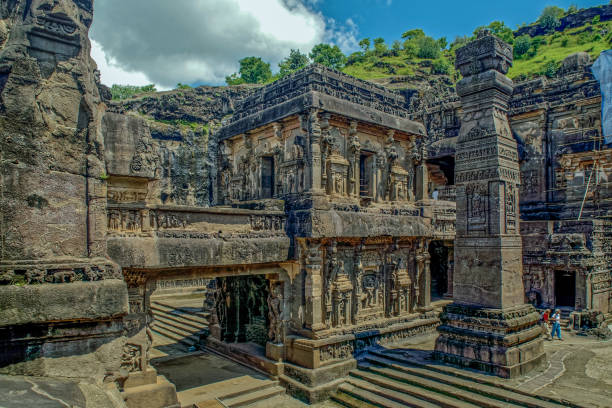
The Ellora Caves, located in Maharashtra, India, are a remarkable complex of rock-cut caves which dated back to between the 5th and 10th centuries CE. Ellora caves comprised Hindu, Buddhist and Jain temples and over 100 caves, under that 34 caves are available to the public. 17 Caves belong to the Hindus, 12 Buddhist and 5 for Jain’s with deities, carving, and even monasteries the mythology of each religion.
Hindu and Buddhist Caves were built during Rashtrakuta dynasty and Jain caves were built by the Yadav dynasty. Hindu period from 753 to 982 CE, Buddhist period from 600 to 730 CE and Jain’s periods from 1187 to 1317 CE. Let’s divide the history of Ellora into 3 parts based on 3 major religions;
-
Hindu Monuments
It is the initial phase of the Ellora Caves periods, built during the 6th to 8th century in the Kalachuris period. Cave number 14, 15 and 16 were built in Rashtrakuta periods. Hindu caves majorly belong to the God of Shiva and other Hindu gods also. Lingam yoni is placed in the center of the shrine.
– Kailashnath Temple
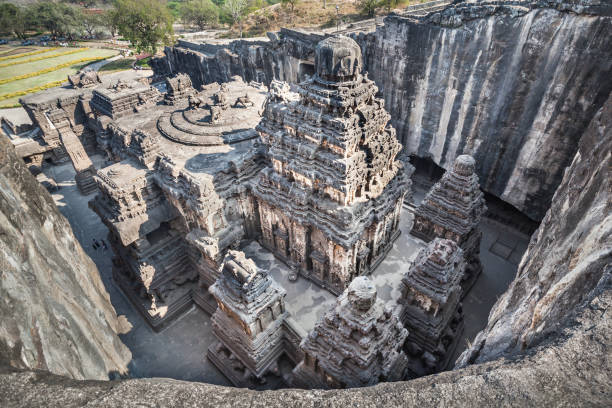
World’s most interesting and rare temple in this world carved out of a single rock. Dedicated to (Kailashnath) one of the largest and most famous being the Kailasa Temple (Cave 16), dedicated to Lord Shiva. Temple houses of lingam yoni, space for circumambulation, assembly hall, gateways and square pattern. Other gods like Vishnu, Saraswathi, Ganga and Vedic.another interesting feature is mandapa, which is made by the Dravidian architectures with 16 pillars. Built by the Rashtrakuta King I and believed to have weighed 2, 00,000 tonnes and moved around 3 million cubic ft. stones. Carved from a single rock and showcasing elaborate carvings and designs.
-
Buddhist Monuments
Situated in the southern part of the Ellora Caves, and probably built around 600 to 730 CE. Some historians argue that these monuments were built before the Hindu monuments, but reality is not true. Initially cave number 6, 11, and 12 being built and these caves include monasteries, shrines.
-Vishwakarma Cave

Cave number 10 is called Vishwakarma Cave, built around 650 CE. Cave is also called “Carpenter’s Cave”, because it looks like a wooden beam. You can also see Stupa hall inside this cave, which is a 15 ft. where statue of Buddha sitting in a preaching pose. Vishwakarma Cave has a prayer house and 8 cells and also a portico.
-
Jain Monument
Probably you may have seen and heard about Hinduism and Buddhism, but Jainism is also a popular religion born and equivalent to Buddhism in India. Here total 5 caves belong to this religion, especially for Digambara sect of Jainism. Most of these caves were carved during the 9th and 10th centuries. Mandapa and pillared verandah are common here with yaksha, yakshi goddesses and paintings of Jain mythologies.
– Chota Kailash

Built during the same time of Kailashnath temple or Cave 16 that’s why the name is given as Chota Kailash. Built in the 9th century along with Indra Sabha. Temple includes 2 gigantic statues of Indra and 8 and 12 armed dancing poses. Jainism caves are much smaller than the rest of the religious caves with features of deities and dancers.
2. Location
Ellora temple is a series of 34 Caves including Hinduism, Buddhism and Jainism, located in the Indian State of Maharashtra. Just 80 km or 50 miles away from the Ajanta Cave temple. 30 km away from Aurangabad and 172 km away from Nasik.
3. Tickets
– Indians: ₹40 per person
– Foreigners: ₹600 per person
– SAARC and BIMSTEC countries peoples: ₹40 per person
– Children’s below the age of 15 years are free to enter.
As a traveler you can also visit the official website and book tickets online for yourself, family and friends. It is always a better idea to get current prices and avoid rush too.
4. Built by the
Majority of Ellora Cave temples were built by the Rashtrakuta Dynasty during the 753 to 982 CE, especially caves of Hinduism and Buddhism. But the Jain Caves were built during the time of Yadava dynasty in 1187 to 1317 CE.
5. Timings
Ellora Cave Temple is open to the general public from 6 AM to 6 PM every day except Tuesday and public holidays. Always make a plan to visit caves during the months of November to March.
The combination of religious significance and artistic achievement makes both Ajanta and Ellora perfect example to the rich Indian art and cultures. UNESCO World Heritage sites which shows us a significant landmark in Indian heritage and deep root of the Indian religious and mutual respect between them. Also these caves illustrate the coexistence of different faiths and artistic styles during a flourishing period of Indian history.
Suggested Reads; Hampi, India
Angkor Wat Temple, Cambodia- 8th new wonders of the world.
Q: Ajanta Caves built by which dynasty?

A: Ajanta Caves were built by the 2 major Indian Dynasties such as Satavahana dynasty and Vakatak dynasty. Cave no, 9, 10, 12, 13 and 15A was built by the Satavahana dynasty which is belongs to Hinayana group of Buddhism and Cave number 1-8, 11 and 14-29 belongs to Vakatak dynasty to Mahayana phase.
Q: Ellora Caves located in which state?
A: Ellora Caves located in the Indian State of Maharashtra.
Q: Ajanta Caves located in which state?
A: The Ajanta Caves are located in the Aurangabad district of the Indian state of Maharashtra. It is just 100 kilometers (62 miles) from the city of Aurangabad.
Q: Ellora Caves closed on which day?
A: Ellora caves not available to general public on Tuesday. Except Tuesday caves are open to public from 6 AM to 6 PM.
Q: What is the Ajanta and Ellora caves distance?
A: Total distance between Ajanta and Ellora caves is around 106 km.

